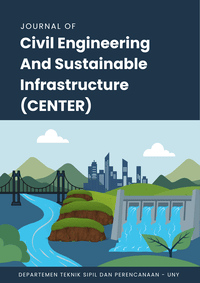Efek Penambahan Manufacture Sand Terhadap Kuat Tekan, Porositas, dan Percolation Rate Pervious Concrete
DOI:
https://doi.org/10.21831/center.v1i1.1393Keywords:
Abu batu, Beton porous, Kuat tekan, Laju perkolasi, PorositasAbstract
Berkembangnya suatu perkotaan selalu disertai dengan pesatnya pembangunan infrastruktur yang memberikan banyak manfaat bagi masyarakat. Namun seiring dengan bertambahnya infrastruktur yang dibangun, daerah hijau untuk resapan air kian berkurang. Penelitian dilakukan dengan tujuan untuk mengetahui pengaruh penambahan M-sand atau manufactured sand terhadap kuat tekan, porositas, dan percolation rate pervious concrete. Penelitian menerapkan metode eksperimen yang dilakukan di Laboratorium Bahan Bangunan, Departemen Pendidikan Teknik Sipil dan Perencanaan, Fakultas Teknik, Universitas Negeri Yogyakarta. Penambahan M-sand dibagi menjadi 4 variasi yaitu 0%, 5%, 10%, dan 15%. Sampel benda uji sebanyak 20 silinder dengan diameter 150 mm dan tinggi 300 mm. Benda uji diuji setelah masa perawatan 28 hari. Hasil data yang diperoleh dianalisis secara deskriptif kuantitatif guna mengetahui efek yang diberikan dari penambahan M-sand. Nilai kuat tekan rata – rata pervious concrete dengan 0%, 5%, 10%, dan 15% M-sand berturut – turut adalah 10,5 MPa, 12,3 MPa, 8,8 MPa, dan 5,9 MPa. Nilai porositas rerata pervious concrete dengan 0%, 5%, 10%, dan 15% M-sand berturut – turut adalah 15,02%, 10,40%, 10,38%, dan 11,99%. Nilai percolation rate rerata pervious concrete dengan 0%, 5%, 10%, dan 15% M-sand berturut– turut adalah 0,4125 cm/s, 0,1476 cm/s, 0,1314 cm/s, dan 0,1607 cm/s. Hasil penelitian menyatakan campuran terbaik untuk pervious concrete adalah penambahan 5% M-sand karena mendapatkan nilai kuat tekan tertinggi dengan porositas yang masih mencukupi.
Downloads
References
[1] American Concrete Institute. (2011). ACI – 522R Report on Pervious concrete. America: ACI.
[2] Bari, V., et. al. (2021). Experimental Studies on Pervious Concrete by Varying the Size of Aggregate and Sand Content. International Journal of Engineering Research & Technology (IJERT). NTASU–2020. 9(3). ISSN (Online): 2278-0181. College of Engineering and Technology Mumbai University Mumbai. India. DOI: 10.17577/IJERTCONV9IS03034.
[3] Husain, N., Roshni, J.J., & Suroshe. (2015). ”Effect of Aggregate Grading Andcementitious by-Product on Performance of Pervious Concrete.” International Journal of Innovative Research in Science, Engineering and Technology (IJIRSET). 4 (8). DOI: 10.15680/IJIRSET.2015.0408026
[4] Meininger, R. C., (1988). No fines pervious concrete for paving. Concrete International, V, 10 Aug., pp.20- 27.
[5] Neithalath, N., Weiss, J., & Olek, J. (2004). Predicting the Permeability of Pervious Concrete (Enhanced Porosity Concrete) from Non-Destructive Electrical Measurements. Department of Civil and Environmental Engineering. Clarkson University.
[6] Neithalath, N., Weiss, J., & Olek, J. (2006). Characterizing Enhanced Porosity Concrete Using Electrical Impedance to Predict its Acoustic and Hydraulic Performance. Cement and Concrete Research. 36 (11). 2074-2085 pp.
[7] Pandei R. W. et. al. (2019). Studi Eksperimen Pengaruh Pemanfaatan Superplasticizer Terhadap Kuat Tekan dan Permeabilitas Beton Berpori (Pervious concrete). Politeknologi Vol 18 No. 1. Jurusan Teknik Sipil, Politeknik Negeri Manado, Manado.
[8] Prabowo D. A., Setyawan A., & Sambowo K. A. (2013). Desain Beton Berpori untuk Perkerasan Jalan yang Ramah Lingkungan. e-Jurnal Matriks Teknik Sipil. Jurusan Teknik Sipil, Fakultas Teknik, Universitas Sebelas Maret, Surakarta.
[9] Widodo, S., Santosa, A., & Prapto, P. (2006). Pemanfaatan Limbah Abu Batu sebagai Bahan Pengisi dalam Produksi Self-Compacting Concrete. INERSIA: Informasi dan Ekspose Hasil Riset Teknik Sipil dan Arsitektur, 2(2), 39-46.
Downloads
Published
How to Cite
Issue
Section
License
Copyright (c) 2024 Ramadhan Dicky Atmanto Putro, Slamet Widodo

This work is licensed under a Creative Commons Attribution 4.0 International License.
Authors who publish with CENTER journal agree to the following terms:
- Authors retain copyright and grant the INERSIA journal right of first publication with the work simultaneously licensed under Creative Commons Attribution License (CC BY 4.0) that allows others to share the work with an acknowledgment of the work's authorship and initial publication in this journal.
- Authors can enter into separate, additional contractual arrangements for the non-exclusive distribution of the published version of the work (e.g., post it to an institutional repository or edit it in a book), with an acknowledgment of its initial publication in this journal.
- Authors are permitted and encouraged to post their work online (e.g., in institutional repositories or on their website) before and during the submission process, as it can lead to productive exchanges, as well as earlier and greater citation of published work.

CENTER by was distributed under a Creative Commons Attribution 4.0 International License






